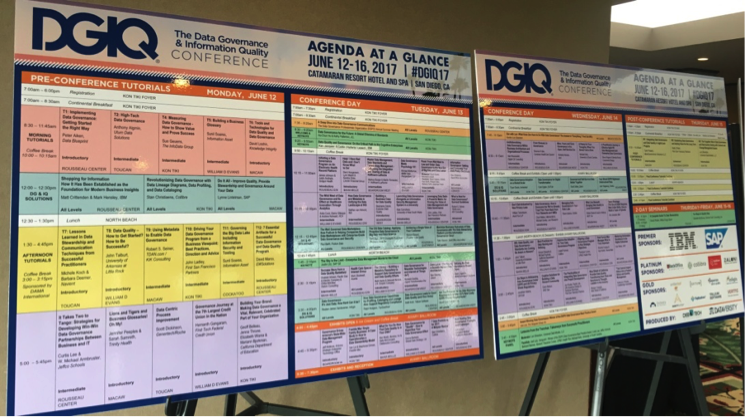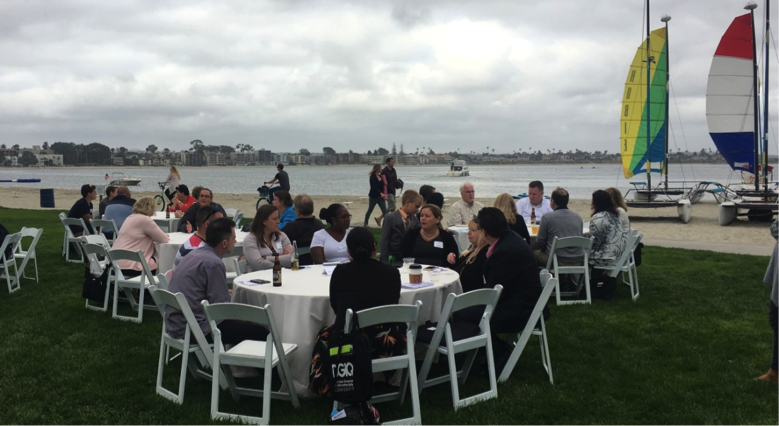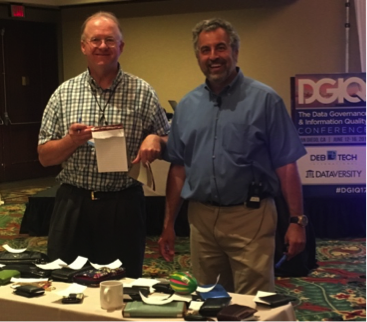 The 2017 Data Governance and Information Quality (DGIQ) Conference (www.dgiqconference.com), hosted by Debtech International and DATAVERSITY, took place in sunny San Diego, California, from June 12 to June 16.
The 2017 Data Governance and Information Quality (DGIQ) Conference (www.dgiqconference.com), hosted by Debtech International and DATAVERSITY, took place in sunny San Diego, California, from June 12 to June 16.
It offered tutorials and presentations, a vendor showcase, and various networking opportunities with fellow attendees.
This DGIQ immersion deepened my knowledge of data governance and my appreciation of the challenges in making a data governance program successful.
The conference was held in a beautiful setting; the Catamaran Resort. Just 2 blocks off the ocean in Pacific Beach, it’s a tropical resort set on a quiet bay. The conference made optimal use of the venue, hosting some presentations in paddle steamers docked just outside the hotel, and treating us to lunch outdoors every day under a bright blue sky!
This conference addresses all levels of experience, from getting started through to the experienced. As new challenges and opportunities arise over time, this conference is a good way to learn about them. Did you know the European GDPR (General Data Protection Regulation) comes into effect in May 2018? If you weren’t aware of this, it’s time you learned about it! Unstructured data, data lakes, predictive analytics models, and data blending all need data governance in varying degrees. Do you know the unique challenges these present, and the options for addressing them?
Some people have asked me how they can justify the cost of coming to a week-long conference. All I can say is that the whole is greater than the sum of the parts. The ability to immerse yourself in the content and discuss learnings with your fellow attendees deepens your understanding and yields insights you can apply when you return to work. Data governance is not cheap, so consider this conference an investment in the success of your program!
It was good to see that I’m not the only one who appreciates this investment. DGIQ 2017 had record attendance (over 550 people) and record sponsorship. There was a pretty even split of business and IT attendees, along with a healthy number of younger attendees, a promising sign of continuity in data governance wisdom.
What did I learn? In a nutshell: not to underestimate the value of change management (and, this is not only to leverage your change management team if you have one, but to consider and address culture and communication in everything you do!). Speak the business’ language, express data governance requirements in business terms (if it’s not supporting the business, why are you doing it?). Find data stewards by recognizing existing talent in your company, formalizing their roles, and empowering them. Start small, deliver, and build momentum. Track metrics from day one (proving value, thus securing further funding). Know business and regulatory (e.g. GDPR) requirements. Look beyond structured data to unstructured data, blended data, data lakes, and predictive analytics models, too. Track data debt (analogous to Agile’s technical debt). Better yet, don’t accrue data debt! Make software subordinate to data (software comes and goes, data lives on!).
If you’d like to know more, I’ve summarized some highlights of the sessions I attended. Perhaps you’ll glean a few ideas to apply to your DG practice now. And, perhaps you’ll want to learn more at the Data Governance Winter Conference 2017 in Florida this December, or at DGIQ 2018 in San Diego next spring!
Pre-Conference Networking
Getting a head start on the conference, the DGPO (Data Governance Professionals Organization) organized a networking event for their members, late afternoon on June 11. Five tables were assigned an expert on a specific topic: About the DGPO, Process, DG Fundamentals and Metrics, Stewardship and Communication, and Organization. On arrival, each person received a card detailing their own unique sequence of tables. These cards ensured everyone met new attendees as they visited each of the five tables. A win-win opportunity to discuss best practices with experts and meet a variety of new faces before the conference even started. Unfortunately, San Diego’s usually sunny weather let us down (the only time, all week!), and the event had to be called off after the first three 20-minute rotations. I applaud the DGPO for organizing this creative event, and hope to see such events again in the future!
Pre-Conference Tutorials
The first day of the conference was primarily dedicated to half-day tutorials. Some were introductory, ideal for those who were new to data governance or information quality. Some highlighted best practices from practitioners in the field. Some delved into details, such as metrics, tools and techniques, and data lakes.
I started with “Implementing Data Governance: Getting Started the Right Way”, presented by Peter Aiken (Data Blueprint). While you might think this was targeted at first-time data governance, it was equally relevant to those who were looking to re-boot their data governance program.
The large room was packed with attendees, largely first-timers to this conference, who came to learn how to structure data governance that would be seen as meaningful by their organization. Just a few of the many valuable points from Peter’s tutorial:
- Tie DG initiatives to business goals, describe the business benefits;
- Start small; don’t boil the ocean (but do consider the longer term). Build a strong foundation;
- Find ways to streamline. E.g., instead of creating a data inventory, find a way to capture information about data as it is uncovered;
- Communication is key, e.g., tell something seven times (not once), using business terms (not DG terms).
In the afternoon, I attended Sunil Soares (Information Asset’s ) “Governing the Big Data Lake including Information Security and Tooling”.
Big data is simply another form of data that needs to be governed. Some data, such as exploratory data, may only need a light touch. But conversely, there are some significant new wrinkles to consider. For example:
- Could a predictive analytics model be unintentionally profiling (e.g., using zip code, which could correlate with race or nation of origin)? If so, it could be inappropriately or illegally discriminating (e.g. see GDPR Article 22, “Automated individual decision-making, including profiling”);
- Do you know where sensitive data resides – in unstructured data, in data lakes, in blended data (where business users have created new data from existing data)? Would you be able to mask it, as required?
- If you used Facebook data, e.g., for phone number, would you be able to delete this data if you were unfriended/unliked?
The DGPO Annual Summer Meeting
Tuesday morning started early, with the Data Governance Professionals Organization (DGPO’s) Annual Summer Meeting, which introduced us to the organization, followed by “A Deep Dive into Data Governance Communications”.
Anne Buff first reviewed the DGPO’s goals and benefits of membership (offering access to prior webcasts, DG best practices, discounts to conferences, and access to the 2017 submissions for DGPO Best Practice Award – excellent value for anyone interested in data governance!).
Her key messages on DG Communications:
- It’s a program, not a project;
- You need executive support;
- Be a data storyteller. Use communications templates, keep people in the loop, don’t over communicate.
Opening Keynotes
The conference officially opened with 2 keynote sessions.
First, Ho-Chun Ho and Kathy Patterson, from JLL, presented “Data Governance for the Future: A Global Dilemma of Standards”. JLL is a global professional services and investment management firm specializing in real estate. They face the challenging situation of dealing with many independent companies, all with their own standards.
They recommend using standards as much as possible, but
- Recognize the need to review all entries for suitability, be able to work outside standards as required (e.g. ISO-3166 where some country codes are contested);
- Be able to handle conflicting standards, and work with standards organizations to reconcile differences;
- Be adaptable, e.g., in real estate, how do you manage an office when it is a railway car with no fixed address?
This was followed by Caitlin (Halferty) Lepech and Ken Jacquier, IBM Analytics, “Data Quality & Governance: On the Critical Path to the Cognitive Enterprises”. They have created a cognitive journey map for data governance, to scale and augment their DG expertise. I liked their use of TaaS – Trust as a Service – a familiar form of acronym in a company that also speaks of SaaS, PaaS and Iaas. They ended by sharing their goals for Information Governance, which are concise and compelling: Make Data Simple, Make Data Make Money, Make Data Available, and Make Data Compliant.
After the two tutorials on Monday, I finished the day with “Building Your Brand: Making Data Governance a Vital, Relevant, Celebrated Part of Your Organization”, presented by Mariann Bjorkman, Geoff Belleau, Jenna Throne and Elizabeth Wisnia from the California Department of Education.
This was the first of several compelling presentations that portrayed communication and change management as key success factors in their data governance program. For example:
- Am I speaking their language? Am I considering WIIFT (What’s In It For Them)?
- Sell service, not compliance (be more carrot, less stick);
- We are all storytellers (we need to tell good stories to make an impact);
- Be approachable, build personal connections;
- Communicate in a variety of ways (have a brand and a logo, use Facebook and Twitter, host an internal data conference. Even create a cartoon!)
Following the keynotes on Tuesday morning, I chose another session relating to the human side of DG: “Data Governance Meets Psychology 101” by Michael McMorrow (MMM Data Perspectives).
My favorite quote from this session: “The biggest problem with communication is the illusion that it has taken place” (George Bernard Shaw). This is a key issue in DG programs. Michael listed various factors that influence perception and communication. By being aware of these, you can increase communication and thereby success, by:
- Using the power of “Because” (giving a reason, any reason, increases acceptance);
- Using the advantages of attractiveness, height, authority;
- Getting someone to make a series of small decisions, rather than one large decision (foot-in-the-door technique);
- Getting people to make commitments (especially public commitments);
- Doing favors, so people reciprocate;
- Using social proof (if others are doing it, it’s more credible).
I followed this with a session about a highly-useful metric: “Leveraging Data Debt – a Powerful Metric for Proving the Value of Data Management and Data Governance”, by John Ladley (First San Francisco Partners).
Data debt is inspired by Agile’s technical debt and financial accounting (the mindset of having a liability on the balance sheet).
John’s premise is that we incur data debt when we choose not to manage data well. In projects, there is often a focus on on-time delivery of a specific solution. This can encourage the deferral of data issues, such as misaligned BI (Business Intelligence) or poor data quality. As these deferred data issues accumulate, the sum total may become untenable.
John closed with a success story of a company that started recording data debt. After 2 years, the backlog was presented to executives. The accruing liability was sufficiently alarming that they demanded all future projects document data debt. By making data debt visible, options could be discussed. The outcome? In the last six months, no further data debt was incurred!
After lunch, there was a keynote from Justin Litz (SAP), entitled “The Sky is the Limit – Enterprise Data Management moves to the Cloud”. I regret being detained, thus missing most of the keynote. But I caught one comment that I really appreciated: treat data governance as a solutions team, not a data team. It’s another way of switching the mindset to focus on business needs.
In “Success Story from a Data Quality Battlefield”, Shakeel Ahmed (Pacific Gas & Electric Company) and Chitta Shirolkar (Slalom Consulting), their company had a simple, clear business case for needing quality data. They needed to submit homeowner energy savings to a portal – every submission that was rejected, reduced their income. They prioritized issues based on high business impact / low volumes, and created common business metrics to show quarterly progress. Their key messages: show success, no finger pointing; find a common currency to align stakeholders; WIIFT (drivers and incentives); data quality is everyone’s responsibility; think big, start small, act fast!
In “Data Governance by ‘Stealth’ – How to Right-Size your Data Governance Effort”, Donna Burbank (Global Data Strategy, Ltd.) shone a data storyteller. Good advice was combined with engaging stories that clearly illustrated her points. Some tips from her session:
- Data governance not only mitigates risk but also generates opportunities; focus on the business value of data governance where possible;
- Prioritize business-critical data, and have a pyramid of priority (with Master Data at the top and exploratory data at the bottom, where a lighter data touch (e.g. privacy, sensitive data) may suffice;
- Implement only just enough data governance to get the job done;
- Insert some key data questions into the agile programming process, small questions can have a big impact!
In addition to the presentations, Tuesday’s schedule allowed time for an ice cream social and a reception in the exhibit area.
The following morning started with an unusual session – a meditation / data governance hybrid hosted by Len Silverston, “Zen with Len – What does Zen Have to Do with Data Governance? The Answer is ‘Everything’. Find out why”. It was billed as an enlightening, wonderful session to start your day in a relaxed and receptive state of mind!
Len led us through several meditation exercises, while relating them to data governance. A simple example is ‘stop’. Meditation gives you a chance to stop, empty your mind, and relax. In data governance, a good conflict management tool is also to stop. Namely, before reacting to a conflict, take time out to think things through. This simple technique can reduce / help you avoid conflicts and escalations, for a more harmonious and successful data governance program!
We attendees did indeed start the following session in a relaxed, receptive state of mind. As such, I’ve accepted Len’s challenge to find just one minute every day for simple meditation, and I am continuing to enjoy my moments of Zen!
Given funding for DG programs is typically a challenge, I was curious to see Michael Kelly (University of South Carolina)’s suggestions in, “A Penny for Your Thoughts, When You haven’t got a Dime”. He offered five strategies for implementing data governance on a limited budget. These included capitalizing on what you already have (find people who are already acting as stewards, and clarify their roles / empower them), affirming competing priorities (help departments see who else needs their data, and which data elements are critical), and delivering on your promises (quick wins, if visible, build momentum). He also pointed out that incident reports and audit findings can be your friend, if DG can help the business resolve the issues!
On another common challenge of business resistance, Cheri Mallory (Method 360) and Michael Grosky (Lam Research) described their approach in “Data Governance. How to Overcome the ‘We’ve already tried this’ Push Back from your Stewards and SMEs”. Some of their key points were to do the detective work, to translate your message for your audience, and to embrace the fun.
For example, to engage data stewards and subject matter experts (SMEs) in using a data quality tool, the data governance team profiled data, wrote and vetted definitions, and created views with user-friendly column names. Only then did they schedule several sessions of combined lecture/demo/hands-on training based on the company’s data, with additional optional hands-on training at the end. These sessions were so well-received that additional sessions were scheduled to meet demand. By starting with metadata and real world examples, rather than diving into detailed processes, the staff was kept engaged.
On a lighter note, Gena Nelson (ONE Gas) proved the value of “Creative Solutions for Building a Data Steward Community”. She used fun events like Data Palooza and a Data Quality Haunted House to engage the community, communicate, and get input. For example, at one such event, she set up a wall of graffiti with the theme
“If I had cleaner data _______________” .
The answers helped her build a business case that netted a year of funding!
Closing Keynotes
The conference had a three-part closing. First, the DGPO announced the winners of the DGPO Data Governance Best Practices Award. Out of 18 excellent submissions, they selected TIAA and Dun & Bradstreet as Finalists, and Vanguard as the winner.
After all three organizations received their awards, Joel Lutz (The Vanguard Group) had the honor of presenting the “Award Winning Data Governance Keynote: Winner of the DGPO Data Governance Best Practice Award”. Two highlights stood out for me; one was their list of data governance focus areas. From a long list, they were boiled down to 33, and then just to four focus areas: what data do we have; where is it; what systems are using that data for what purpose; and does the data meet regulatory and business requirements? This helped them focus their DG on what matters most. The second highlight was the maturity of their IT project delivery. The project delivery lifecycle explicitly addresses any changes to enterprise data, ensuring the right data stewards are involved in changes and requiring their signoff. It’s a great way to ensure the ongoing quality of their data assets!
Further details of Vanguard’s Best Practices, along with the other 17 Best-Practice Award submissions, can be viewed in the members-only section of the DGPO website.
The final portion of the closing keynotes was a panel “Lessons from the Trenches – Takeaways from Successful Practitioners”, featuring moderator Len Silverston (Universal Data Models), and panelists Joel Lutz (The Vanguard Group), Curtis Lee (Jeffco Schools), Barbara Deemer (Navient), Theodore Curran (UPMC Health Plan), and Michael Kelly (University of South Carolina). Their lessons included capturing metrics from the start; having a clear vision and continuing to reiterate it; communicating (in a variety of ways, consider blogging, interactive training, etc.); and the value of switching the DG mindset from compliance to service. They also made the observation that data governance is getting sexy (!).
Len finished by giving each panelist a moment to present a picture with a quick closing remark. These were:
- Assemble a data governance dream team;
- Think like an owner;
- Hack feedback (create tighter / faster positive feedback loops so data owners can make changes, and see results, quickly);
- Stockdale Paradox (retain faith that you will prevail in the end and simultaneously deal with the brutal day-to-day);
- Keep perspective and a sense of humor;
Sponsors and Vendors
This conference not only had a record number of attendees, but also a record number of sponsors. This was reflected in the vendor room, which was filled with a broad variety of vendors covering both tools and services.
There was plenty of time to talk with the vendors on Tuesday (first while enjoying ice cream, and later drinks and appetizers) and again on Wednesday (while enjoying dessert). The vendors were generous with their gifts, including several draws for the popular Amazon Echo Dot.
The conference schedule allotted several half-hour time slots specifically for vendor presentations. These half-hour slots were boon to those who were reluctant to talk with vendors directly (i.e., shy), and another helpful means to learn more about various vendors and their offerings.
The list of sponsors, including a brief summary and website, is available on the DGIQ 2017 website, for those who didn’t finish making the rounds during the conference itself.
Post-Conference Tutorials and Seminars
After another relaxing “Zen with Len” meditation on Thursday morning (added to the schedule by popular demand), there were three one-day tutorials and two two-day seminars to choose from.
I stuck with the communications theme and attended Len Silverston’s one-day “The Forgotten Side of Data Governance and Data Quality Dealing with Cultural and Change Management Issues”. It wasn’t an easy decision as the two competing tutorials on “Sustaining Data Governance and Adding Value for the Long Term” (Kelle O’Neal, First San Francisco Partners), and “Integrating Data Governance and Data Quality into Agile/Lean Projects” (Tami Flowers, MetaGovernance Solutions), looked equally interesting.
Len’s session was an illuminating journey through various facets of communication that can facilitate, or impede, data governance. All were illustrated with real-life data governance stories where these were (or were not) applied, and with an exercise that brought the content to life. “Trust” was the first to be addressed. In going through the exercise, we experienced first-hand the trust we ask of data stewards when working with their data. As the exercise progressed, we could see tensions dissipate and trust grow as issues were raised and successfully addressed.
I would recommend this tutorial to anyone that would like to better understand the critical roles that vision, trust, communication, motivation, conflict resolution, involvement, and leadership play in data governance programs.
Finally, in addition to the three one-day tutorials, there were two two-day seminars offering a deeper dive into data governance and data quality. These allowed attendees to supplement the conference with detailed training, getting extra value for their travel dollars.
The two seminars were “A Complete Guide to Data Stewardship” (David Plotkin, Wells Fargo) and “Ten Steps to Quality Data” (Danette McGilvray, Granite Falls Consulting). From speaking with attendees during the morning break on Thursday, I can confirm they were both well-worth attending!
Conclusion
It’s a strength of this conference that it offers a various formats, from a wide variety of short presentations to the deeper dives offered by the tutorials and seminars. Coupled with the vendor show and the networking, it’s been a valuable learning experience.
I’m very glad I attended the conference and I have already been able to share my learnings in conversations with my local networks (Calgary DAMA and Alberta Data Architecture). If you know people from your company who attended, buy them a coffee and benefit from what they learned. If you don’t, keep an eye on the DGIQ LinkedIn group (https://www.linkedin.com/groups/1798139) and the DGPO organization for webcasts, etc. And start planning for the DG Winter Conference 2017 or for DGIQ 2018, you won’t regret it!





